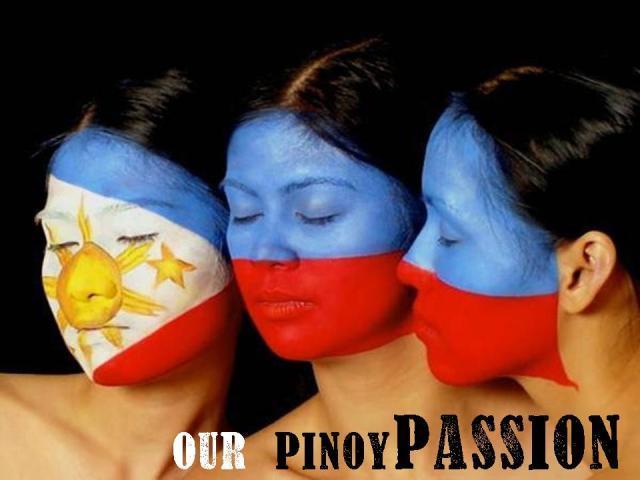To start off my entries on Filipino food, here are
some basic facts I gathered!
 1) Do you know that Filipinos regard enjoying food to be a "National Obsession"?
1) Do you know that Filipinos regard enjoying food to be a "National Obsession"?Yes! Its true! To the Filipinos, food is important as it is an integral part of local art and culture as well as communal existence. Believe it or not but Filipinos eat up to ELEVEN times a day! That means a total of five meals a day and snacks in between.
2) Do you know that the Philippine cuisine is a unique mixture from the East and the West?There is probably nowhere else in the world where you can sample delectable and tempting delicacies if not in the exotic country of Philippines. Yes, due to nearly 400 years of external influences, the Filipino cuisine has evolved to become a fascinating blend of Malay,Spanish and Chinese cultures.
3) Do you know that Philippine cuisine is often labeled as bland and mild?Unlike its surrounding Asian counterparts like Malaysia and Indonesia that uses hot chilies liberally in their dishes, the Philippine cuisine is more suitable for those with sedate and sensitive taste buds.
4) Do you know what is their must-have for meals? As with other Asian countries, rice is their staple food and will be served with most meals. For over 2,000 years, rice has been grown in the Philippines and is eaten almost daily. As of the 21st century, over twenty varieties of rice are cultivated, which are made into thousands of different cakes, noodles, and pancakes. Rice noodles are now increasingly common in fast-food restaurants and stands, because noodles symbolize prosperity, long life, and good luck. Filipinos believe the longer the noodles, the better, so noodles are generally not broken or cut when a dish is being prepared.
5) Do you know Filipinos love to use coconuts in creating their exotic Filipino dishes?It is indeed no secret that coconuts are used liberally to create Filipino dishes. Cooking meat and vegetables using coconut milk create dishes called guinatan. These dishes originated from the Malay side of the Filipino cuisine. Apart from that, coconuts are also great for creating mouth-watering desserts like bibingka and macapuno
 General MacArthur is a popular figure in Philippines and I remember learning of his famous phrase "I came through and I shall return" (which he said during World War 2 pledging his return to defeat the Japanese forces) during History class last time! He was the Field Marshall & Military Advisor for the Philippines Army before World War 2 and became Commander of US forces in the Far East before World War 2. However, General MacArthur was forced to leave Philippines in 1942 during the Japanese attack & subsequent invasion. He left Philippines but pledged to return and defeat the Japanese forces. At the ending stages of World War 2, he led the Allied Forces to defeat the Japanese Army during Battle for Manila in 1945.
General MacArthur is a popular figure in Philippines and I remember learning of his famous phrase "I came through and I shall return" (which he said during World War 2 pledging his return to defeat the Japanese forces) during History class last time! He was the Field Marshall & Military Advisor for the Philippines Army before World War 2 and became Commander of US forces in the Far East before World War 2. However, General MacArthur was forced to leave Philippines in 1942 during the Japanese attack & subsequent invasion. He left Philippines but pledged to return and defeat the Japanese forces. At the ending stages of World War 2, he led the Allied Forces to defeat the Japanese Army during Battle for Manila in 1945. ever lived in Manila Hotel's penthouse from from 1935 - 1941!The original building was 5 stories tall, a modern tower has since been added. The "MacArthur Suite" was his penthouse, with spectacular views of the harbor and a replica of his office, only the table and chair are original. The hotel was the scene of room-to-room fighting during the battle for Manila in February 1945 and burned by the Japanese during the fighting by accident. A new multi-level portion of the hotel was built post war.The catastrophic battle resulted to serious damages. Approximately 100, 000 civilians died and 50,000 were hurt andwounded. On the American side, 1,010 soldiers from different units died while 5,565 were wounded giving a total of 6,575 casualties. As for the Japanese casualties, it was recorded that about 16,000 soldiers died during the battle.
ever lived in Manila Hotel's penthouse from from 1935 - 1941!The original building was 5 stories tall, a modern tower has since been added. The "MacArthur Suite" was his penthouse, with spectacular views of the harbor and a replica of his office, only the table and chair are original. The hotel was the scene of room-to-room fighting during the battle for Manila in February 1945 and burned by the Japanese during the fighting by accident. A new multi-level portion of the hotel was built post war.The catastrophic battle resulted to serious damages. Approximately 100, 000 civilians died and 50,000 were hurt andwounded. On the American side, 1,010 soldiers from different units died while 5,565 were wounded giving a total of 6,575 casualties. As for the Japanese casualties, it was recorded that about 16,000 soldiers died during the battle.











































 2) An investment destination
2) An investment destination 


